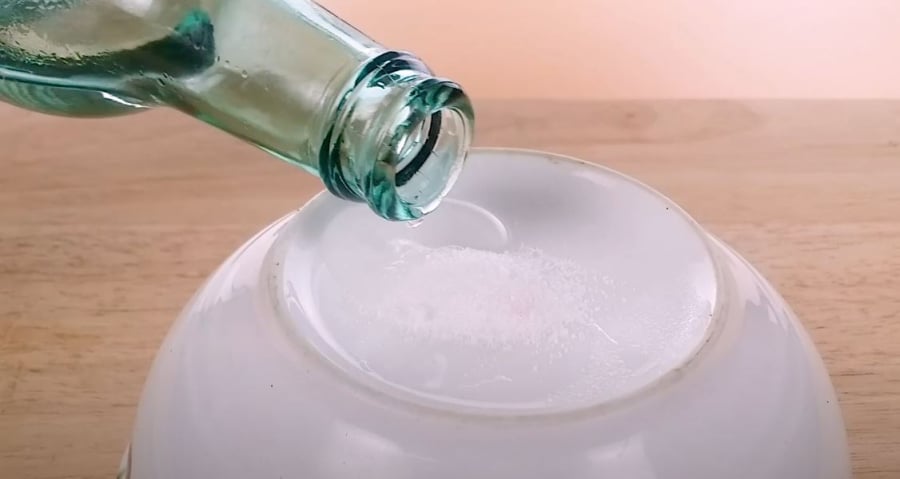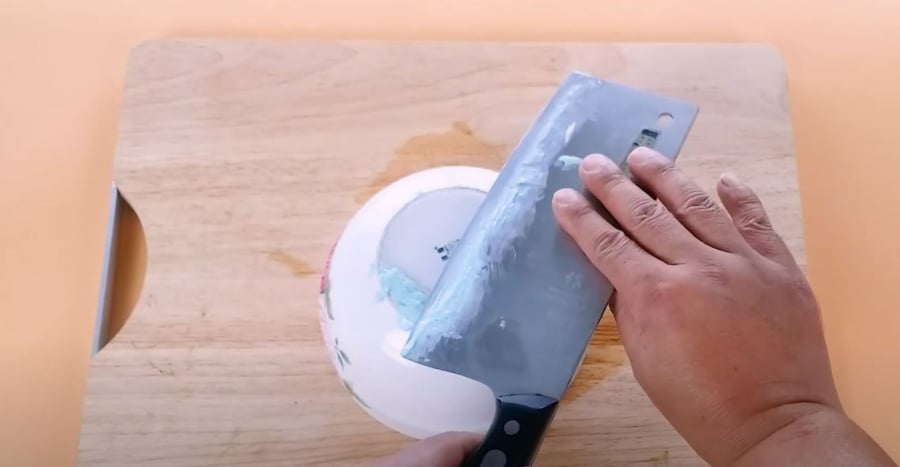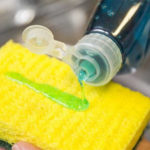A dull knife in the kitchen can make food preparation a challenging task. While whetstones are commonly used to sharpen knives, they require skill and effort. Fortunately, there are alternative methods to achieve a sharp edge without relying on a whetstone.
In this innovative approach, you’ll only need a ceramic bowl or plate, some salt, toothpaste, and white vinegar. First, turn the bowl or plate upside down and place it on a table or flat surface.

Combine salt, toothpaste, and white vinegar in the center of the upside-down bowl before sharpening.
Prepare a mixture of salt, toothpaste, and white vinegar in the center of the upside-down bowl. Using a sponge or dish scrubber, apply this mixture to the knife blade. Hold the knife and place the blade against the rim of the bowl, sharpening it by moving the knife in one direction. Spend approximately three minutes on each side of the blade, regularly applying the salt, toothpaste, and vinegar mixture for a sharper and brighter edge.
Maintain a ten-degree angle between the knife blade and the bowl’s rim for optimal sharpness, and always sharpen in a single direction to avoid chipping. This technique ensures a sharp edge without the risk of damage.

Sharpen the knife blade by repeatedly running it along the rim of the bowl until it’s sharp and shiny.
Once you’re satisfied with the sharpness, simply rinse the knife with clean water.
Alternative Sharpening Methods
– Baking Soda and White Vinegar
Create a paste by mixing baking soda and white vinegar in a bowl. This combination will fizz slightly. Apply this paste to the entire surface of the knife blade and let it sit for about ten minutes. This process helps soften and loosen any rust or tarnish on the knife.
After the mixture has done its work, rinse the knife with water, and the rust should come off more easily. For a complete finish, sprinkle salt on the knife and use an old toothbrush to scrub away any remaining rust. Finally, rinse the knife again with clean water.
As a final step, turn a bowl or plate upside down and sprinkle some salt on the rim. Hold the knife at a ten-degree angle and sharpen it by running the blade along the rim in a single direction. Spend about three minutes on each side of the blade, and feel free to add more salt during the process for better results.
– Newspaper Roll
If you have some old newspapers lying around, they can be put to good use! Roll up a few sheets of newspaper tightly to form a cylindrical shape that fits comfortably in your hand. Secure it with tape. Have a bowl of water ready nearby. Dip one end of the newspaper roll into the water, and then vigorously rub it against the knife blade. Repeat this process for both sides of the knife. Within minutes, your knife will be as good as new.

Sandpaper is another effective tool for sharpening knife blades.
If you have sandpaper or sandpaper sheets, they can be used for knife sharpening as well. Place a sheet of sandpaper on a cutting board or similar surface. Hold the sandpaper in place with one hand while using the other hand to sharpen the knife, tilting it at a ten-degree angle to the sandpaper. Focus on the blade, and remember to sharpen in one direction only. The more you sharpen, the sharper your knife will become.
The Secret Power of Toothpaste: A Kitchen Knife’s Best Friend
 Toothpaste: A Kitchen Knife’s Best Friend’>
Toothpaste: A Kitchen Knife’s Best Friend’>Toothpaste is not just for maintaining oral hygiene; it has a myriad of unexpected uses in our daily lives.
The Ultimate Guide to Knife Care: Cleaning and Maintenance
Introducing the ultimate guide to knife care and maintenance! Knives are an essential tool in any kitchen, but do you know how to keep them in top condition? With our expert tips, you’ll learn the secrets to proper knife cleaning and storage, ensuring your knives stay sharp and pristine. From preventing rust to mastering the perfect edge, we’ll take you through the ins and outs of knife care, so you can chop, slice, and dice like a pro. Stay tuned for the ultimate upgrade to your kitchen skills!


































